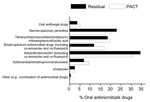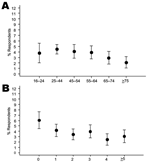Volume 12, Number 10—October 2006
Research
Antimicrobial Drugs in the Home, United Kingdom
Abstract
A total of 6% of 6,983 households in the United Kingdom had leftover antimicrobial drugs, and 4% had standby antimicrobial drugs. Respondents with leftover drugs were more educated, more knowledgeable about antimicrobial drugs, younger, and female. Of respondents with leftover drugs, 44% kept them in case of future need, and 18% had taken these drugs without medical advice.
Antimicrobial drug resistance is increasing worldwide and is related to use of these drugs (1,2). Use of leftover drugs may increase antimicrobial drug resistance in the community by exerting selective pressure in the commensal flora (3,4). Retention and use of leftover antimicrobial drugs are widespread in countries that sell antimicrobial drugs without a prescription (i.e., over-the-counter) (5,6). In countries in which over-the-counter antimicrobial drug sales are restricted, studies on use of leftover drugs have been few and mostly questionnaire-based, relying on respondent recall (7,8). A large survey of British household drug practices showed that 2% of medicines were leftover or standby drugs (9), but no information was obtained about the households containing them. To inform antimicrobial drug education campaigns (10,11) and research examining the relationship between antimicrobial drug prescribing and resistance (12), we conducted a household survey to identify antimicrobial drugs present and the characteristics of respondents who kept them.
The survey formed part of the Office for National Statistics' Omnibus Survey in the United Kingdom in February, March, June, and July 2003. A representative sample of households was selected by using previously published methods (9). Households were invited by letter to participate in a study about their views and experiences on a variety of subjects. For households with >1 adult member, 1 person >16 years of age was selected by a random number tables. At the household visit, respondents were informed that the survey was sponsored by the department of health and was about drugs for treating infections. Respondents were asked to show the interviewer all drugs in the household that had been prescribed for infections, even if the person for whom they were prescribed was not present (temporarily or permanently), and asked whether the drugs were currently being used for an infection for which they were prescribed, had been prescribed for a previous infection (leftover drugs), or were being kept for use in the future (standby drugs). The amount of unused drug was noted and prescription details were recorded and coded by their listing in the British National Formulary. Antimicrobial drugs included all antifungal and antibacterial drugs.
Respondents were asked a series of questions about their use of antimicrobial drugs and whether they agreed or disagreed with a series of statements from education campaigns (10,11) about the usefulness of these drugs for coughs and colds, viruses, bacteria, and normal flora; the importance of completing courses of drug therapy, and antimicrobial drug resistance. Ethical approval was not required for this ongoing national survey, but respondents were able to refuse participation in any part of the survey at any time and were told that all information was anonymous and strictly confidential.
To enable comparison with nationally prescribed antimicrobial drugs, the number of community-prescribed drugs in England was obtained from prescribing analysis and cost data (PACT) (13). Sampling weights based on the 2001 census data for Great Britain were applied to household and respondent data to allow for any oversampling or undersampling by region, Carstair's deprivation quintile, age group, and sex. Multivariable logistic regression (ignoring sampling weights) was used to investigate independent associations between respondent characteristics and the presence of leftover antimicrobial drugs prescribed for the respondent.
Of 10,981 selected households, 25% refused to participate and 10% could not be contacted. Respondents in 7,120 (65%) households completed the questionnaire and 6,983 (64%) agreed to the drug survey. A total of 19% of the 6,983 households had an antimicrobial drug leftover (6%), kept for standby use (4%), or currently in use (11%) (Table 1). Six percent of leftover drugs had been prescribed for <3 days, 16% for 4–5 days, 61% for >6 days, and 17% were to be taken as required. No specific class of oral antimicrobial drugs was kept more often as leftover drugs relative to PACT prescription rates (Figure 1).
Four percent of respondents had leftover antimicrobial drugs that had been prescribed. The most educated respondents were twice as likely as those least educated to have leftover antimicrobial drugs (5.4% with a university degree vs. 2.4% with no formal degree) (Table 2). Respondents most knowledgeable about antimicrobial drugs (6.1% if all 11 questions were answered correctly) were twice as likely as those least knowledgeable (3.1% if >5 were answered incorrectly) to keep them (Table 2, Figure 2). Level of education and knowledge of antimicrobial drugs were independently associated with being more likely to have leftover drugs (Table 2). Younger respondents and women were more likely to have leftover drugs (Table 2, Figure 2). Thirty-eight percent of respondents' leftover drugs had been dispensed >1 year earlier, and 48% of these drugs had more than half of the original amount remaining (Table 1). Of those who had kept a leftover antimicrobial drug prescribed in the past year, 44% did so for future need (Table 1). Of those with a leftover drug, 18% had taken antimicrobial drugs without advice compared with 4% of respondents who did not have a leftover drug (p<0.0005).
When directly questioned, 38% of respondents (95% confidence interval 36.4–38.8%) recalled that they had been prescribed a drug in the past year. Younger age in women (50% if 16–24 years of age, 43% if 25–44 years of age, and 44% if 45–54 years of age) and lower level of education (33% with a degree and 40% with no formal qualifications on leaving school at the minimum age [16 years]) were independently associated with being prescribed an antimicrobial drug.
This large survey of household antimicrobial drugs, which was conducted in a country with restricted over-the-counter sales, showed an association between keeping leftover antimicrobial drugs and higher education and knowledge about these drugs, younger age, and being female. The strength of this study is that we asked a large representative sample to show us their antimicrobial drugs rather than relying on respondent memory. However, we may not have been shown all antimicrobial drugs, and some of the leftover drugs may have been misclassified as standby drugs. The characteristics of respondents in households with standby drugs were similar to those of respondents with leftover drugs. The number of antimicrobial drugs found was twice that found by a recent survey in Sweden that relied on respondent recall; in that study, the respondents also reported a lower number of antimicrobial drug prescriptions (8).
Persons may keep leftover antimicrobial drugs because too much was prescribed for their initial infection. Most community-acquired infections are respiratory or urinary, for which many prescribed courses of antimicrobial drugs are longer than necessary (14). If the standard duration of treatment could be shortened and package size reduced to contain enough drug for 3 to 5 days, the temptation to keep antimicrobial drugs might be diminished. Our finding supports this suggestion because prescriptions for >6 days constituted 61% of leftover drugs, whereas prescriptions for <3 days constituted 6% of leftover drugs. Evidence shows that repeated treatment with antimicrobial drugs exerts greater selective pressure on normal bacterial flora than a single course of treatment (14,15). Consequently, persons who use leftover antimicrobial drugs repeatedly are at greater risk for colonization and infection with drug-resistant organisms (1,3,4,15).
Our results show that any public education campaign to reduce retention and use of leftover antimicrobial drugs must be directed at well-educated groups rather than the less educated, who are prescribed more antimicrobial drugs. One explanation may be that well-educated people are confident that they can make their own decisions about antimicrobial drug use, and this may be particularly relevant when their infection is less severe or becomes asymptomatic. Furthermore, they do not discard these drugs because 44% of those with leftover antimicrobial drugs admitted keeping them in case of future need. Antimicrobial drug education campaigns should reinforce the message that leftover drugs should be returned to the pharmacist or that these drugs should only be taken after the advice of a health professional.
Our finding of high levels of leftover antimicrobial drugs suggests that prescription does not equate to use. This will be an important source of bias in epidemiologic studies examining risk factors for antimicrobial drug resistance (12) that include dose and duration of antimicrobial drug treatment in their analysis of exposure (1,4).
Dr McNulty is a consultant medical microbiologist and head of the Health Protection Agency Primary Care Unit in Gloucester, UK. Her research interests include management of infectious disease in primary care, guidance development, and facilitation of education.
Acknowledgments
We thank the staff at the Office for National Statistics who were involved in the household survey, in particular, Amanda Wilmot, Alessio Fiacco, and Laura Rainford, and staff at the Department of Health, who provided the PACT data, in particular, Candida Ballantyne, Anne Custance, and Anne Emery.
This study was supported by a grant from the Department of Health, England, whose staff had no involvement in the design, collection, analysis, or interpretation of data in this study or in writing this paper or submitting it for publication.
References
- Donnan PT, Wei L, Steinke DT, Phillips G, Clarke R, Noone A, Presence of bacteriuria caused by trimethoprim-resistant bacteria in patients prescribed antibiotics: multilevel model with practice and individual patient data. BMJ. 2004;328:1297. DOIPubMedGoogle Scholar
- Goossens H, Ferech M. Vander-Stichele-R, Elseviers M. Outpatient antibiotic use in Europe and association with resistance: a cross-national database study. Lancet. 2005;365:579–87.PubMedGoogle Scholar
- Gustafsson I, Sjölund M, Torell E, Johannesson M, Engstrand L, Cars O, Bacteria with increased mutation frequency and antibiotic resistance are enriched in the commensal flora of patients with high antibiotic usage. J Antimicrob Chemother. 2003;52:645–50. DOIPubMedGoogle Scholar
- Jonsson M, Qvarnstrom Y, Engstrand L, Swedberg G. Clarithromycin treatment selects for persistent macrolide-resistant bacteria in throat commensal flora. Int J Antimicrob Agents. 2005;25:68–74. DOIPubMedGoogle Scholar
- Stratchounski LS, Andreeva IV, Ratchina SA, Galkin DV, Petrotchenkova NA, Demin AA, The inventory of antibiotics in Russian home medicine cabinets. Clin Infect Dis. 2003;37:498–505. DOIPubMedGoogle Scholar
- Okumura J, Wakai S, Umenai T. Drug utilisation and self-medication in rural communities in Vietnam. Soc Sci Med. 2002;54:1875–86. DOIPubMedGoogle Scholar
- Ceaser S, Wurtz R. "Leftover" antibiotics in the medicine cabinet. Ann Intern Med. 2000;133:74.PubMedGoogle Scholar
- Svensson E, Haaijer-Ruskamp FM, Lundborg CS. Self-medication with antibiotics in a Swedish general population. Scand J Infect Dis. 2004;36:450–2. DOIPubMedGoogle Scholar
- Woolf M. Left-over medicines, a report on OPCS omnibus survey data. OPCS Omnibus Survey Publications Report 4. London: Her Majesty's Stationery Office; 1995.
- Finch RG, Joshua MP, Davey PG, Baker LJ. Educational interventions to improve antibiotic use in the community: report from the International Forum on Antibiotic Resistance (IFAR) colloquium, 2002. Lancet Infect Dis. 2004;4:44–53. DOIPubMedGoogle Scholar
- Department of Health Standing Medical Advisory Committee on Antimicrobial Resistance. The path of least resistance. Occasional report. London: The Stationery Office; 1998.
- Steinke D, Davey P. Association between antibiotic resistance and community prescribing: a critical review of bias and confounding in published studies. Clin Infect Dis. 2001;33(Suppl 3):S193–205. DOIPubMedGoogle Scholar
- Lovejoy AE, Savage I. Prescribing analysis and cost tabulation (PACT) data: an introduction. Br J Community Nurs. 2001;6:62–7.PubMedGoogle Scholar
- Magee JT. The resistance ratchet: theoretical implications of cyclic selection pressure. J Antimicrob Chemother. 2005;56:427–30. DOIPubMedGoogle Scholar
Figures
Tables
Cite This ArticleTable of Contents – Volume 12, Number 10—October 2006
| EID Search Options |
|---|
|
|
|
|
|
|


Please use the form below to submit correspondence to the authors or contact them at the following address:
Cliodna A.M. McNulty, Health Protection Agency Primary Care Unit, Microbiology Department, Gloucestershire Royal Hospital, Great Western Rd, Gloucester GL1 3NN, UK
Top